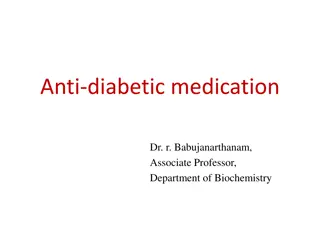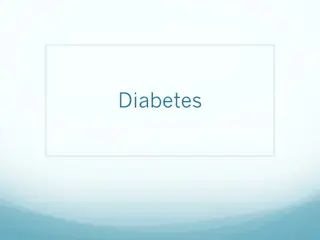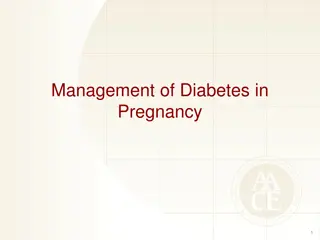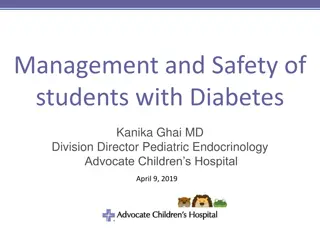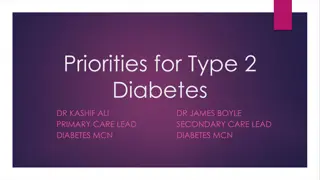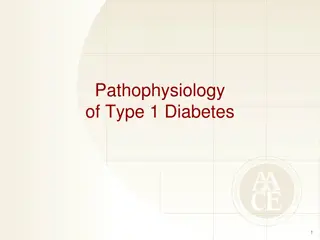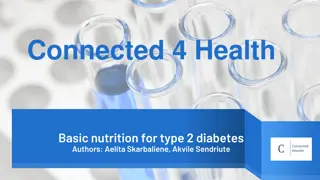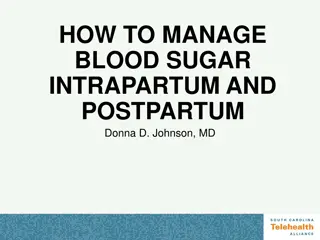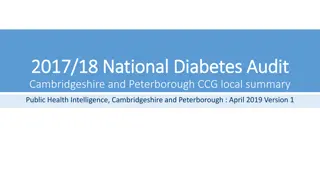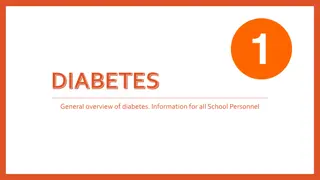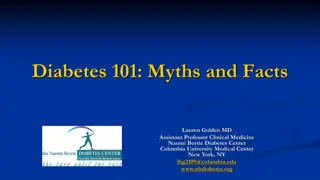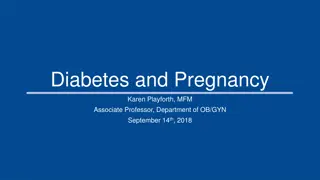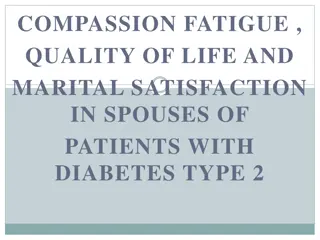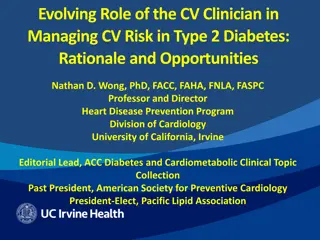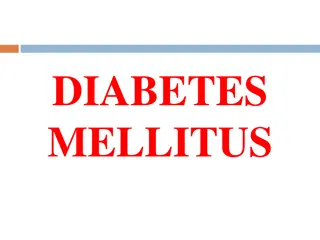
Basal Insulin Management in Type 2 Diabetes
Learn about the importance of basal insulin therapy in managing type 2 diabetes, including considerations for initiation, dosage adjustments, and choice between basal insulin analogs and NPH insulin. Understand the role of basal insulin in combination therapy to achieve target glucose levels while minimizing hypoglycemia risk. Explore recommendations from AACE/ACE/ADA 2016 guidelines for optimizing basal insulin treatment.
Download Presentation

Please find below an Image/Link to download the presentation.
The content on the website is provided AS IS for your information and personal use only. It may not be sold, licensed, or shared on other websites without obtaining consent from the author. If you encounter any issues during the download, it is possible that the publisher has removed the file from their server.
You are allowed to download the files provided on this website for personal or commercial use, subject to the condition that they are used lawfully. All files are the property of their respective owners.
The content on the website is provided AS IS for your information and personal use only. It may not be sold, licensed, or shared on other websites without obtaining consent from the author.
E N D
Presentation Transcript
COMPREHENSIVE TYPE 2 DIABETES MANAGEMENT ALGORITHM part 2 AACE/ACE/ADA 2016 M.Heidarpour
Insulin Insulin is the most potent glucose-lowering agent. However, many factors come into play when deciding to start insulin therapy and choosing the initial insulin formulation. These decisions, made in collaboration with the patient, depend greatly on each patient s motivation, cardiovascular and end- organ complications, age, general well-being, risk of hypoglycemia, and overall health status, as well as cost considerations.
Patients taking 2 oral antihyperglycemic agents who have an A1C >8.0% and/or long-standing T2D are unlikely to reach their target A1C with a third oral antihyperglycemic agent.
Although adding a GLP-1 receptor agonist as the third agent may successfully lower glycemia, eventually many patients will still require insulin. In such cases, a single daily dose of basal insulin should be added to the regimen. The dosage should be adjusted at regular and fairly short intervals to achieve the glucose target while avoiding hypoglycemia.
Basal Insulin Basal insulin alone is the most convenient initial insulin regimen, beginning at 10 units or 0.1 0.2 units/kg, depending on the degree of hyperglycemia. Basal insulin is usually prescribed in conjunction with metformin and possibly one additional noninsulin agent. ADA.2016
Basal insulin analogs are preferred over neutral protamine Hagedorn (NPH) insulin because a single basal dose provides a relatively flat serum insulin concentration for up to 24 hours. Although insulin analogs and NPH have been shown to be equally effective in reducing A1C in clinical trials, insulin analogs caused significantly less hypoglycemia.
While there is evidence for reduced risk of hypoglycemia with newer, longer-acting, basal insulin analogs, people with type 2 diabetes without history of hypoglycemia or severe hypoglycemia may use NPH safely at much lower cost. ADA.2016
Premixed insulins provide less dosing flexibility and have been associated with a higher frequency of hypoglycemic events compared to basal and basal- bolus regimens. Nevertheless, there are some patients for whom a simpler regimen using these agents is a reasonable compromise.
If basal insulin has been titrated to an acceptable fasting blood glucose level, but A1C remains above target, consider advancing to combination injectable therapy to cover postprandial glucose excursions. ADA.2016
Options include: adding a GLP-1 receptor agonist or mealtime insulin, consisting of one to three injections of rapid-acting insulin analog(lispro, aspart, or glulisine) administered just before eating. ADA.2016
Noninsulin agents may be continued, although sulfonylureas, DPP-4 inhibitors, and GLP-1 receptor agonists are typically stopped once more complex insulin regimens beyond basal are used. In patients with suboptimal blood glucose control, especially those requiring increasing insulin doses, adjunctive use of thiazolidinediones (usually pioglitazone) or SGLT2 inhibitors may be helpful in improving control and reducing the amount of insulin needed. ADA.2016
A less studied alternative, transitioning from basal insulin to twice-daily premixed (or biphasic) insulin analogs (70/30 aspart mix, 75/25 or 50/50 lispro mix), could also be considered; pharmacodynamics profiles make them suboptimal to cover post prandial glucose excursions. ADA.2016
Patients whose basal insulin regimens fail to provide glucose control may benefit from the addition of a GLP-1 receptor agonist, SGLT-2 inhibitor, or DPP-4 inhibitor When added to insulin therapy. The incretins and SGLT-2 inhibitors enhance glucose reductions and may minimize weight gain without increasing the risk of hypoglycemia, and the incretins also increase endogenous insulin secretion in response to meals, reducing postprandial hyperglycemia. Depending on patient response, basal insulin dose may need to be reduced to avoid hypoglycemia.
Patients whose glycemia remains uncontrolled while receiving basal insulin and those with symptomatic hyperglycemia may require combined basal and mealtime bolus insulin. Rapid-acting analogs (lispro, aspart, or glulisine) or inhaled insulin are preferred over regular human insulin because the former have a more rapid onset and offset of action and are associated with less hypoglycemia.
The simplest approach is to cover the largest meal with a prandial injection of a rapid-acting insulin analog or inhaled insulin and then add additional mealtime insulin later, if needed. Several randomized controlled trials have shown that the stepwise addition of prandial insulin to basal insulin is safe and effective in achieving target A1C with a low rate of hypoglycemia. A full basal-bolus program is the most effective insulin regimen and provides greater flexibility for patients with variable mealtimes and meal carbohydrate content.
Inhaled Insulin Inhaled insulin is now available for prandial use with a more limited dosing range and may require serial lung function testing prior to and after starting therapy. ADA.2016
It is important to avoid hypoglycemia Approximately 7 to 15% of insulin-treated patients experience at least one annual episode of hypoglycemia, and 1 to 2% have severe hypoglycemia. Several large randomized trials found that T2D patients with a history of one or more severe hypoglycemic events have an approximately 2- to 4-fold higher death rate. It has been proposed that hypoglycemia may be a marker for persons at higher risk of death, rather than the proximate cause of death. Patients receiving insulin also gain about 1 to 3 kg more weight than those receiving other agents.
Pramlintide Is indicated for use with basal-bolus insulin regimens. Pioglitazone is indicated for use with insulin at doses of 15 and 30 mg, but this approach may aggravate weight gain. There areno specific approvals for the use of SFUs with insulin, but when they are used together the risks of both weight gain and hypoglycemia increase.
BASAL INSULIN usually with metformin +/- other none insulin agents ADA
BASAL INSULIN usually with metformin +/- other none insulin agents
1 2 3
Hypertension Common DM comorbidity Prevalence depends on diabetes type, age, BMI, ethnicity . Major risk factor for ASCVD & microvascular complications. In T1DM, HTN often results from underlying kidney disease. In T2DM, HTN coexists with other cardiometabolic risk factors. ADA.2016
Recommendations: Hypertension/ Blood Pressure Control Screening and Diagnosis: Blood pressure should be measured at every routine visit.B Patients found to have elevated blood pressure should have blood pressure confirmed on a separate day. B ADA.2016
Elevated BP in patients with T2D is associated with an increased risk of cardiovascular events . AACE recommends that BP control be individualized, but that a target of <130/80 mm Hg is appropriate for most patients.
Less stringent goals may be considered for frail patients with complicated comorbidities or those who have adverse medication effects. whereas a more intensive goal (e.g., <120/80 mm Hg) should be considered for some patients if this target can be reached safely without adverse effects from medication.
Lower BP targets have been shown to be beneficial for patients at high risk for stroke. Among participants in ACCORD BP trial, there were no significant differences in primary cardiovascular outcomes or all- cause mortality between standard therapy (which achieved a mean BP of 133/71 mm Hg) and intensive therapy (mean BP of 119/64 mm Hg).
Intensive therapy did produce a comparatively significant reduction in stroke and microalbuminuria, but these reductions came at the cost of requiring more antihypertensive medications and produced a significantly higher number of serious adverse events (SAEs). Systolic BP 135 mm Hg was associated with decreased nephropathy and a significant reduction in all-cause mortality compared with systolic BP 140 mm Hg.
Below 130 mm Hg, stroke and nephropathy, but not cardiac events, declined further, but SAEs increased by 40%.
Recommendations: Hypertension/ Blood Pressure Control Diastolic Targets Individuals with diabetes should be treated to a diastolic blood pressure goal of<90 mmHg. A Lower diastolic targets, such as<80 mmHg, may be appropriate for certain individuals with diabetes, such as younger patients, those with albuminuria, and/or those with hypertension and one or more additional atherosclerotic cardiovascular disease risk factors, if they can be achieved without undue treatment burden. B ADA.2016
Recommendations: Hypertension/ Blood Pressure Control People with diabetes and hypertension should be treated to a systolic blood pressure goal of <140 mmHg. A Lower systolic targets, such as <130 mmHg, may be appropriate for certain individuals with diabetes, such as younger patients, those with albuminuria, and/or those with hypertension and one or more additional atherosclerotic cardiovascular disease risk factors, if they can be achieved without undue treatment burden. C ADA.2016
Lifestyle therapy can help T2D patients reach their BP goal: Weight loss can improve BP in patients with T2D. Compared with standard intervention, the results of the Look AHEAD trial found that significant weight loss is associated with significant reduction in BP, without the need for increased use of antihypertensive medications.
2.Sodium restriction is recommended for all patients with hypertension. Clinical trials indicate that potassium chloride supplementation is associated with BP reduction in people without diabetes.
3. Numerous studies have shown that moderate alcohol intake is associated with a low incidence of heart disease and cardiovascular mortality. 4.The effect of exercise in lowering BP in people without diabetes has been well-established. In hypertensive patients with T2D, however, exercise appears to have a more modest effect; still, it is reasonable to recommend a regimen of moderately intense physical activity in this population.
The Dietary Approaches to Stop Hypertension (DASH) diet: which is low in sodium and high in dietary potassium, can be recommended for all patients with T2D without renal insufficiency.
Lifestyle therapy for elevated blood pressure consists of: 1. weight loss, if overweight or obese; 2. a Dietary Approaches to Stop Hypertension (DASH)-style dietary pattern including reducing sodium increasing potassium intake moderation of alcohol intake 3. increased physical activity. B ADA.2016
Most patients with T2D and hypertension will require medications to achieve their BP goal: Angiotensin converting enzyme inhibitors (ACEIs), angiotensin II receptor blockers (ARBs), beta blockers, calcium-channel blockers (CCBs), and thiazide diuretics are favored choices for first-line treatment. The selection of medications should be based on factors such as the presence of albuminuria, CVD, heart failure, or post myocardial infarction status as well as patient race/ethnicity, possible metabolic side effects, pill burden, and cost.
Because ACEIs and ARBs can slow progression of nephropathy and retinopathy, they are preferred for patients with T2D. Patients with heart failure could benefit from beta blockers. those with prostatism from alpha blockers. those with coronary artery disease (CAD) from beta blockers or CCBs.
In patients with BP >150/100 mm Hg, 2 agents should be given initially because it is unlikely any single agent would be sufficient to achieve the BP target . ARB/ACEI combination more thandoublesthe risk of renal failure and hyperkalemia and is therefore not recommended.
Treatment : In older adults, pharmacological therapy to achieve treatment goals of <130/70 are not recommended. treating to systolic blood pressure <130 mmHg has not been shown to improve cardiovascular outcomes and treating to diastolic blood pressure <70 mmHg has been associated with higher mortality. C ADA.2016
Treatment: Patients with BP >120/80 should be advised on lifestyle changes to reduce BP. B Patients with confirmed BP >140/90 should, in addition to lifestyle therapy, have prompt initiation and timely subsequent titration of pharmacological therapy to achieve blood pressure goals. A ADA.2016
Pharmacological therapy for patients with diabetes and HTN includes: either an ACE inhibitor or angiotensin II receptor blocker B if one class is not tolerated, substitute the other. C Multiple drug therapy (two or more agents at maximal doses) generally required to achieve BP targets. B ADA.2016
If using ACE inhibitors, ARBs, or diuretics, monitor serum creatinine / eGFR & potassium levels. E In pregnant patients with DM and chronic hypertension, BP targets of 110 129/65 79 mmHg are suggested. ACE inhibitors, ARBs, contraindicated during pregnancy. E ADA.2016
ACE 2016






